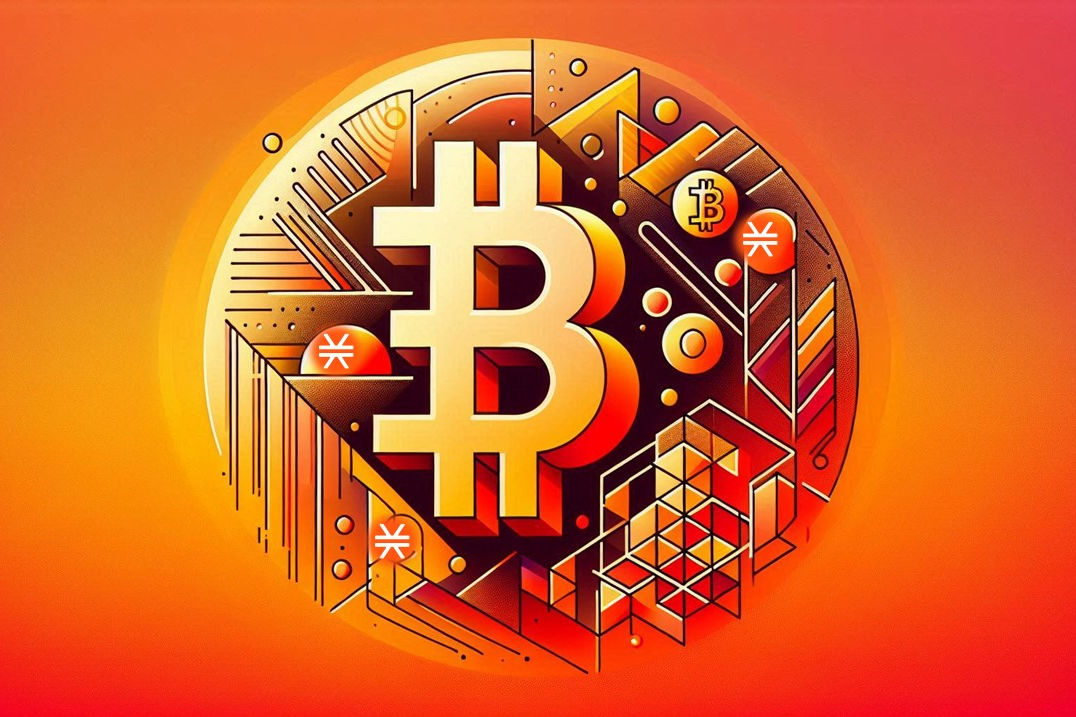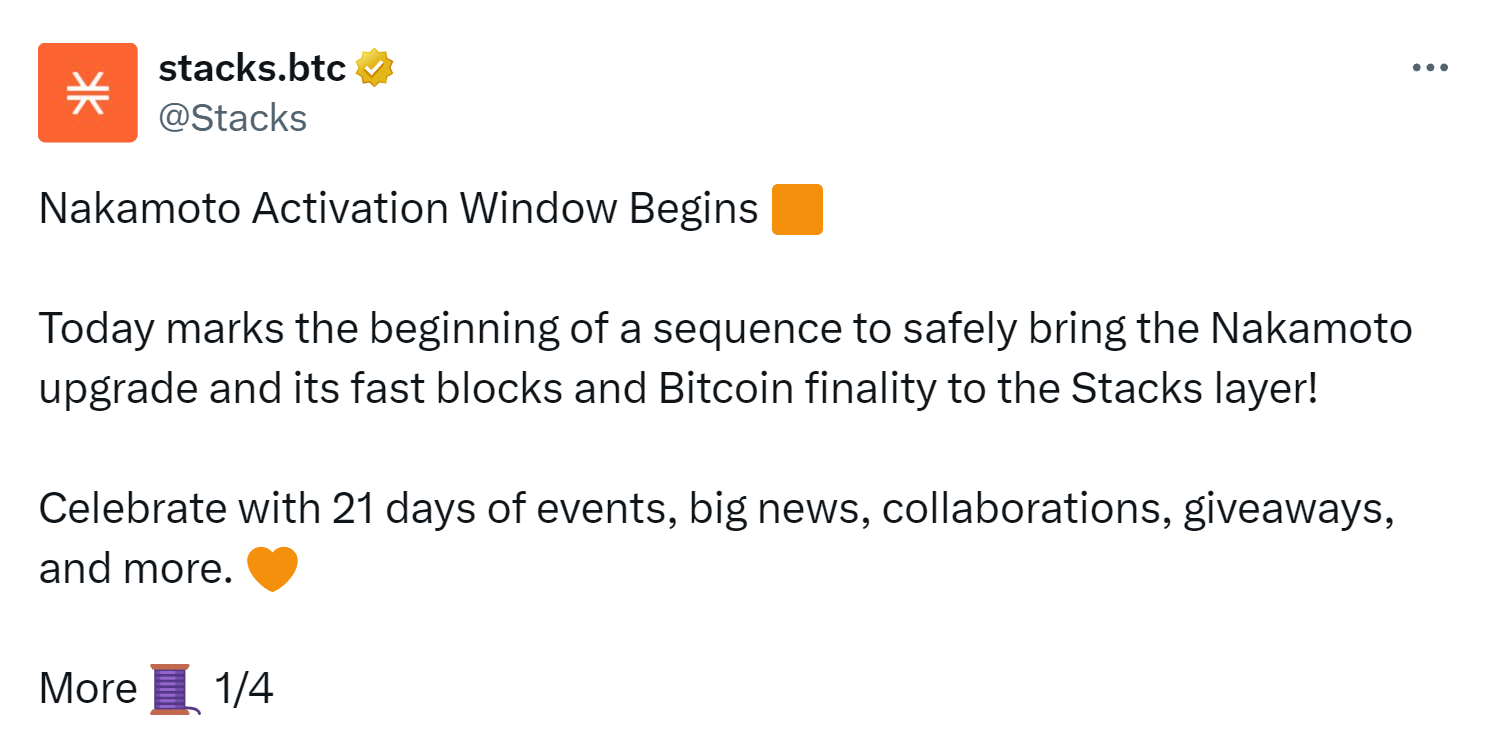2024-08-30

Stacks, a Bitcoin layer-2 network, has
initiated the Nakamoto upgrade on August 28, 2024.
This significant update aims to enhance
the network’s scalability and efficiency by decoupling the block production
schedule from Bitcoin’s.

Nakamoto will boost transaction speeds
on Stacks. The upgrade is expected to reduce settlement times from 10 to 30
minutes or more, that follow Bitcoin’s confirmation time, to about 5 seconds,
which is a substantial improvement over the standard Bitcoin settlement times.
The Nakamoto upgrade has received
strong support from the Stacks community and is seen as a pivotal development
for decentralized finance (DeFi) on the Bitcoin network.
It will also introduce sBTC, a
decentralized asset backed 1:1 by Bitcoin, which is designed to enable smart
contracts and dApps to utilize Bitcoin as a secure base layer.
sBTC is a decentralized asset backed
1:1 by Bitcoin. It facilitates the transfer of BTC between the Bitcoin
blockchain and Stacks, and will also be used as gas in transactions.
Network operators have a two-week
window to implement the Nakamoto upgrade.
Despite the positive changes, the total
value locked (TVL) on the Stacks network has seen a decrease from $189 million
to $88 million, indicating mixed market confidence following the upgrade.
However, this upgrade marks a new era
for DeFi within the Bitcoin ecosystem, potentially unlocking billions in latent
capital and fostering a more dynamic environment.
What is Stacks?
Stacks is a blockchain platform
designed to bring smart contracts and decentralized applications (dApps) to the
Bitcoin network. Unlike most blockchain platforms that operate independently,
Stacks operates as a layer-1 blockchain that is connected to Bitcoin. This
allows Stacks to leverage Bitcoin's security and decentralization while
enabling advanced functionalities such as smart contracts and NFTs
(non-fungible tokens).
Key Features of Stacks:
1.Smart Contracts on Bitcoin
Stacks enables the execution of smart
contracts on Bitcoin without modifying Bitcoin's base layer. These smart
contracts are written in a language called Clarity, which is designed to be
predictable and secure, avoiding many of the pitfalls of other smart contract
languages.
2.Proof of Transfer (PoX)
Stacks uses a unique consensus
mechanism called Proof of Transfer. PoX links the Stacks blockchain to Bitcoin
by allowing Stacks miners to commit Bitcoin in order to mint new Stacks tokens
(STX). This ensures that the Stacks blockchain is anchored to the Bitcoin
blockchain, inheriting its security properties.
3.Clarity Language
Clarity is a new smart contract
language that is intentionally non-Turing complete, which means it avoids
certain computational complexities to enhance security and predictability.
Clarity contracts are transparent and can be easily audited before being deployed,
reducing the risk of bugs or malicious code.
4.Ecosystem of dApps
Stacks supports a growing ecosystem of
decentralized applications. These dApps can use Bitcoin as a base currency
while benefiting from the functionalities provided by the Stacks blockchain.
5.Bitcoin Integration
Stacks allows developers to build
applications that interact directly with Bitcoin, making Bitcoin programmable
and extending its utility beyond being just a store of value or medium of
exchange.
Use Cases
Decentralized Finance (DeFi)
Stacks enables DeFi applications on
Bitcoin, such as decentralized exchanges, lending platforms, and more.
NFTs and Digital Ownership
The platform supports the creation and
trading of NFTs, giving users a way to own and trade digital assets secured by
Bitcoin.
Governance and DAOs
Stacks also supports decentralized
autonomous organizations (DAOs) that can operate with Bitcoin's security and
decentralization.
Stack’s STX token utility
The STX token is the native
cryptocurrency of the Stacks blockchain, and it plays a central role in the
network's ecosystem. Here are the primary utilities of the STX token.
1. Fuel for Smart Contracts and
Transactions:
Transaction Fees
STX is used to pay transaction fees on
the Stacks network. This includes fees for executing smart contracts,
transferring tokens, and interacting with decentralized applications (dApps)
built on Stacks.
Smart Contract Deployment
Developers need STX tokens to deploy
smart contracts on the Stacks blockchain. The token acts as the fuel that
powers these operations, ensuring that the network remains secure and
efficient.
2. Participation in Stacking:
Earning Bitcoin
One of the most unique utilities of the
STX token is its use in the Stacking process. By locking up a certain amount of
STX tokens, users can participate in Stacking and earn Bitcoin (BTC) rewards.
This process is integral to Stacks' Proof of Transfer (PoX) consensus
mechanism, where Bitcoin is transferred to Stackers as a reward for supporting
the network.
Network Security
Stacking helps secure the network by
incentivizing participants to lock up their STX tokens, which in turn enhances
the overall stability and security of the Stacks blockchain.
In summary, Stacks is a unique
blockchain project that extends the capabilities of Bitcoin, bringing smart
contracts, dApps, and more advanced use cases to the Bitcoin ecosystem.